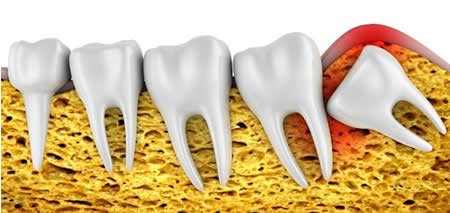Positive Health Online
Your Country

7 Lesser Known Facts About Wisdom Teeth
listed in dentistry, originally published in issue 261 - March 2020
Prehistoric man had a tough life. Their meals consisted of whatever they had hunted during the day. Raw meat, along with raw fruits, vegetables, freshly plucked from the trees around them, were a part of their daily diet.
They also had a set of third molars, which we now know as the wisdom teeth, so that they could properly chew on raw meat, raw fruits, and vegetables. Prehistoric man’s jaws were much larger and more prominent, for the same reason.

As prehistoric man evolved, so did his body. Jaws became smaller, and brains got bigger. Man’s diet changed. There was no need for the third set of molars since the food was cooked and easier to chew. Third molars slowly became redundant.
We generally have 28 teeth, but including wisdom teeth, the count changes to 32, all vying for space. These grow at the back of your mouth, on the bottom, as well as the top. Wisdom teeth don’t have space to develop normally. They get stuck in the jaw, and sometimes, when they erupt, they cause a lot of pain to a person. These are known as impacted wisdom teeth. Here are a few interesting facts about the wisdom tooth:
- A wisdom tooth is called so because these third molars erupt when a person is in their late teenage years. The average age group is 17 to 25, which coincides with the transition from being a kid to an adult with responsibilities. With these responsibilities come wisdom, and hence the name ‘wisdom tooth’;
- Though impacted wisdom teeth are a problem faced by young adults, a wisdom tooth can erupt at any age and cause problems. In fact, the oldest person to have a wisdom tooth eruption, according to the Guinness World Records, was 94-years-old;
- While the English speaking world calls the third molars wisdom teeth, they have different names in different countries. The French call them dents de sagesse, Germans call them Weisheitzähne, Arabs call them ders-al-a’qel, and they are called the teeth of judgment (muelas del juicio) in Spanish. Koreans call them ‘love teeth’ because 17 to 25 is usually the first time someone experiences true love;
- The case of the oldest known erupted wisdom tooth is in the skeleton of a woman who died 15,000 years ago;
- Since a wisdom tooth is an extra appendage, the number of roots of wisdom teeth changes from person to person and depends on your genetic makeup. While someone might have no wisdom teeth, it is possible to have any number of wisdom teeth ranging from one to four. A rarer possibility of having more than four wisdom teeth is known as supernumerary teeth;
- More than 20% of wisdom tooth extractions result in a condition called dry socket. In this condition, a blood clot fails to develop at the site of the extraction, leading to pain and swelling at the site;
- An experimental research study in 2003, at the University of Pittsburgh’s School of Medicine showed that wisdom teeth could potentially be used in stem cell therapy. The study conducted on mice found that stem cells from wisdom teeth can be used to repair damaged corneas. Any clinical applications for humans would require more research. That said, stem cells taken from wisdom teeth could someday be used to repair corneas that have been scarred by infection or injury.
If you are going in for a wisdom tooth removal, don’t be worried about the complications. Your dentist will guide you on ways on how to prevent dry socket and other complications that come with wisdom tooth removal.
References and Bibliographies
1. M.J. Edwards, M.R. Brickley, R.D. Goodey, J.P. Shepherd The cost, effectiveness and cost effectiveness of removal and retention of asymptomatic, disease free third molars. Br Dent J, 187: 380-384. 1999.
2. F. García-Hernández, O. Toro Yagui, M. Vega Vidal, M. Verdejo Meneses Third Molar Agenesis in Young People Between 14 and 20 Years of Age, Antofagasta, Chile Int J Morphol, 26: 825-832. 2008.
3. M.J. Sanchez, A. Vicente, L.A. Bravo Third molar agenesis and craniofacial morphology Angle Orthod, 79: 473-478. 2009.
4. A. Mostowska, A. Kobielak, W.H. Trzeciak Molecular basis of non-syndromic tooth agenesis: mutations of MSX1 and PAX9 reflect their role in patterning human dentition Eur J Oral Sci, 111: 365-370. 2003.
5. A.R.J. Silvestri, I. Singh The unresolved problem of the third molar: would people be better off without it? J Am Dent Assoc, 134: 450-455. 2003.
6. Bonczek, O; Balcar, VJ; Šerý, O. PAX9 gene mutations and tooth agenesis: A review. Clin Genet. 92 (5): 467–476. 2017.
7. Aristotle. The History of Animals. Translated by D'Arcy Wentworth Thompson. Aeterna Press. p. 49. 2015.
Comments:
-
No Article Comments available